

The MacMahon family [1] originated in Ireland and later established itself in France, where it gained prominence. [2] In the context of French nobility, the head of the family holds the titles of Duc de Magenta and Marquis de MacMahon.


The MacMahon family [1] originated in Ireland and later established itself in France, where it gained prominence. [2] In the context of French nobility, the head of the family holds the titles of Duc de Magenta and Marquis de MacMahon.
John MacMahon (1715–1775), an Irish doctor born in Limerick, became naturalised in France in 1749 and married Charlotte Le Belin, Dame d'Éguilly, on 13 April 1750. That same year, King Louis XV of France created him Count d'Equilly. [3] In 1763, John MacMahon further received the title of Marquis d'Éguilly. His son, the 2nd Marquis, served in the American War of Independence, including on the frigate Aigle which the British captured on 15 September 1782. [4] The senior line of the MacMahon family continued until the death of the 5th Marquis in 1894.
Patrice de MacMahon, a grandson of the first Marquis from the MacMahon family's younger line, served with distinction as a general in the Crimean War of 1853–56 and later in the Austro-Sardinian War of 1859, winning the Battle of Magenta on 4 June 1859. The following day Emperor Napoleon III created him Duc de Magenta. Later he became President of the French Republic, serving from 1873 to 1879. [3]
At the 1st Duc de Magenta's death in 1893, his titles passed to his eldest son Armand de MacMahon (1855–1927), who in 1894 also succeeded as 6th Marquis d'Eguilly, thus uniting the titles held by the senior and the younger lines of the MacMahon family. The title of Marquis d'Eguilly was later changed to Marquis de MacMahon.
The family seat of the de MacMahon family was the Château de la Forêt in Montcresson in the Loiret department of north-central France (where the 1st Duke died) but, after 1894, they inherited the current family seat, the Château de Sully in Sully in the Saone-et-Loire department. [5]
The holders of the title of Marquis d'Éguilly have included:
The holders of the title of Duc de Magenta have included: [7]
John MacMahon (or Jean Baptiste de MacMahon) […] who, in 1750, was ennobled by the French Government, and created "Count d'Equilly" […] Marshal Patrick MacMahon, President of the French Republic, Duke of Magenta
Mac-Mahon (Charles-Laure, Marquis de), descended from a noble Irish family who ruined itself for the cause of the Stuarts, and who followed them to France. He was officer of artillery on the Aigle, in 1782 […] when this frigate was stranded at the mouth of the Delaware
{{cite book}}: |work= ignored (help)born Philippe de MacMahon (1938), the fourth Duc de Magenta is also descended from the Bourbon Kings of France and is related to the present chief claimant to the French throne. MacMahon became an illustrious name in France and part of the French nobility

Marie Edme Patrice Maurice de MacMahon, marquis de MacMahon, duc de Magenta, was a French general and politician, with the distinction of Marshal of France. He served as Chief of State of France from 1873 to 1875 and as President of France from 1875 to 1879.
The Most Serene House of Bourbon-Condé, named after Condé-en-Brie, was a French princely house and a cadet branch of the House of Bourbon. The name of the house was derived from the title of Prince of Condé that was originally assumed around 1557 by the French Protestant leader Louis de Bourbon (1530–1569), uncle of King Henry IV of France, and borne by his male-line descendants.
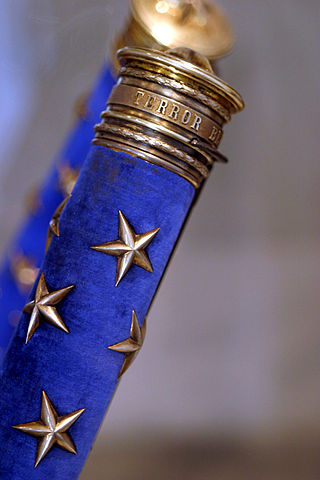
Marshal of France is a French military distinction, rather than a military rank, that is awarded to generals for exceptional achievements. The title has been awarded since 1185, though briefly abolished (1793–1804) and for a period dormant (1870–1916). It was one of the Great Officers of the Crown of France during the Ancien Régime and Bourbon Restoration, and one of the Grand Dignitaries of the Empire during the First French Empire.
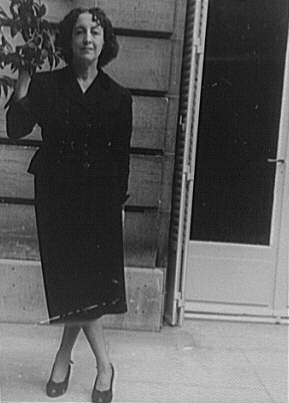
Marie-Laure Henriette Anne de Noailles, Vicomtesse de Noailles was a French artist, regarded one of the 20th century's most daring and influential patrons of the arts, noted for her associations with Salvador Dalí, Balthus, Jean Cocteau, Ned Rorem, Man Ray, Luis Buñuel, Francis Poulenc, Wolfgang Paalen, Jean Hugo, Jean-Michel Frank and others as well as her tempestuous life and eccentric personality. She and her husband financed Ray's film Les Mystères du Château de Dé (1929), Poulenc's Aubade (1929), Buñuel and Dalí's film L'Âge d'Or (1930), and Cocteau's The Blood of a Poet (1930).
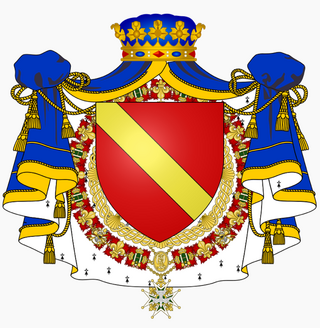
The title of Duke of Noailles was a French peerage created in 1663 for Anne de Noailles, Count of Ayen.

The Château de Sully, situated between Autun and Beaune (Saône-et-Loire), is the largest of the Renaissance châteaux of southern Burgundy. Paired outbuildings of a more vernacular character face each other across a grassed forecourt, while to the rear is the vegetable garden, fenced by fruit trees. The château is approached by an axial stone bridge across its moat. The façades express the traditionally defensive character of the rez-de-chaussée, the ground floor, and the richer, more open aspect of the piano nobile, articulated by pilasters. Under the central pediment that breaks the line of a traditional sloping slate roof, the arched portal is scaled to admit riders and carriages. Four similarly-treated ranges, flanked by matching angled corner towers with pyramidal roofs and surrounded by the moat, enclose a Renaissance courtyard built for the Maréchal de Saulx-Tavanes, confidant of Catherine de' Medici.

The house of la Croix de Castries is a French noble family from Languedoc. The city of Castries in the Caribbean island of Saint Lucia was named after one of its members.
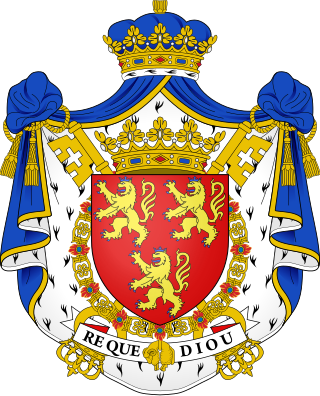
The House of Talleyrand-Périgord is an ancient French noble house. A well-known member of this family was Charles Maurice de Talleyrand-Périgord (1754–1838), who achieved distinction as a French statesman and diplomat. The family name became extinct in 2003 upon the death of Violette de Talleyrand-Périgord.
Events from the year 1874 in France.

Philippe Jules Mancini, 8th Duke of Nevers (1641–1707) was the nephew of Cardinal Mazarin, chief minister of France immediately after the death of King Louis XIII. He was the brother of the five famous Mancini sisters, who, along with two of their female Martinozzi cousins, were known at the court of King Louis XIV of France as the Mazarinettes.

Prince Robert, Duke of Chartres, was the son of Prince Ferdinand Philippe, Duke of Orléans, and thus a grandson of King Louis-Philippe of France. He fought for the Union in the American Civil War, and then for France in the 1870 Franco-Prussian War. In 1863, he married his cousin Princess Françoise of Orléans, the daughter of François, Prince of Joinville. In 1886, he was exiled from France.

Princess Françoise Marie Amélie of Orléans was a member of the House of Orléans and by marriage Duchess of Chartres.
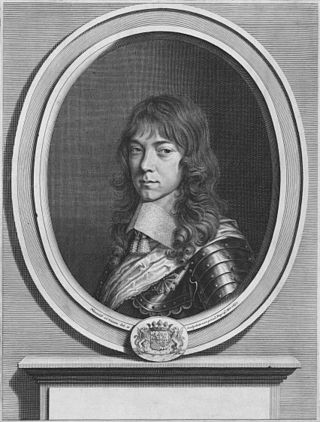
Godefroy Maurice de La Tour d'Auvergne, Duke of Bouillon was a French nobleman and member of the House of La Tour d'Auvergne, one of the most important families in France at the time. He married Marie Anne Mancini, niece of Cardinal Mazarin and had seven children.
Charles MacMahon is the name of:

Élisabeth de Mac Mahon née Elisabeth Charlotte Sophie de la Croix de Castries was the wife of the President of France Patrice de MacMahon.
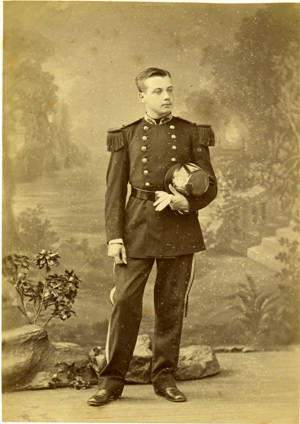
Marie Armand Patrice de Mac Mahon, known as Patrice de Mac Mahon , 2nd Duke of Magenta and 6th Marquis d'Éguilly in 1893, was a French soldier and aristocrat.
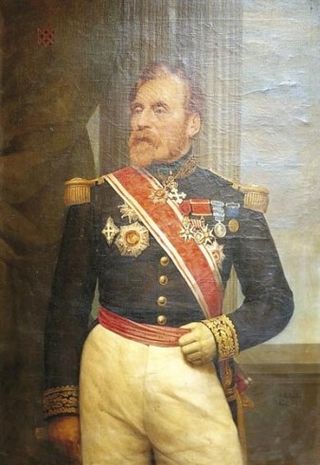
Joseph Édouard de La Motte-Rouge' was a French general and politician.

Marguerite Marie Françoise Louise d'Orléans, Duchesse de Magenta was a member of the House of Orléans, daughter of Prince Robert d'Orléans, Duke of Chartres and Princess Françoise d'Orléans. She bore the courtesy title of Princess of Orleans.